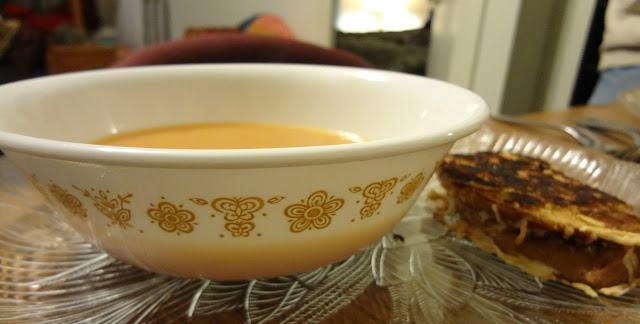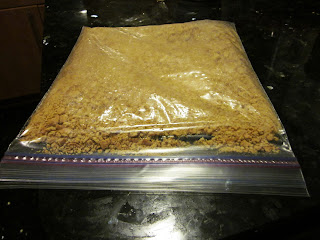 |
| Figure 1. Sea Salted Caramel Brownies |
It has become obvious that we are better at baking desserts than cooking healthy stuff. While contemplating which sugar-packed recipe to make next, we happened upon this recipe for salted caramel brownies. Though we had planned to make a sophisticated meal that day, we abandoned that idea as soon as we saw these brownies in a recipe online.
 | |
|
NFPA ratings:
Difficulty: 4
Not too difficult, but you have to read the directions. The results are well worth it!
Prep. Time: 2 hours. This is an estimate, as we baked these some time ago and neglected to watch the clock. About a quarter of this time will be spent with your tuchus glued to a chair waiting for the brownies to cook. You will really need to use some strong glue because these brownies need to bake in peace.
Course: Midnight snack for students. Dessert for everyone else. Also a decent breakfast!
Materials
Brownies
1) Unsweetened chocolate, roughly chopped - 3 ounces (85 grams)
 |
| Figure 3. Sizzling caramel |
3) Granulated sugar - 1 cup
 |
| Figure 4. It's much easier to break off pieces of caramel than to cut it. |
5) Vanilla extract - 1 teaspoon
6) Flaky sea salt - 0.25 teaspoons, heaping
7) Flour - 0.67 cups
Caramel
1) Granulated sugar - 0.5 cups
2) Unsalted butter - 4 tablespoons
3) Flaky sea salt - 0.25 teaspoons, heaping
4) Heavy cream - 3 tablespoons
Methods
Caramel
1) Melt sugar in a medium, dry saucepan. This takes about 5 minutes. Don't stop stirring!! The sugar should turn brown.
2) Remove from heat. Stir in butter, then the cream and salt.
3) Return to medium-high heat. Simmer and melt any remaining solid butter. The mixture should bubble. When it darkens, pour it onto a parchment paper-covered plate and freeze it until it solidifies. This will take about 30 minutes.
Brownies
1) Pre-heat oven to 350 ºF. Line the bottom and sides of an 8 x 8 inch (ish) pan with parchment paper. Butter or spray the paper so nothing sticks to it.
 |
| Figure 5. Mix the brownies and fold in the caramel. |
3) Add the sugar, eggs, vanilla, and salt. Stir in the flour.
4) When the caramel is solid, remove it from the freezer and chop it into one-inch squares. The caramel will be sticky and difficult to chop. We found it easier to just pull it apart into pieces.
5) Fold most of the caramel pieces into the brownie batter and mix gently.
6) Pour the batter into the parchment paper-covered pan. Place the remaining caramel pieces on top of the batter.
7) Bake for 30 minutes.
8) Eat and marvel at your neurochef skills!
Results
So delicious. Fantastic taste, and not too difficult. These brownies balance caramel with chocolate in a way that is sweet, but not tooth-rottingly sweet. The flavors actually balance really well. You can keep your leftover brownies in the refrigerator or freezer, but make sure to heat them up before you dive back in, both to maintain the structural integrity of your teeth, and to prepare melted caramely goodness for your deserving palette. Also, plop a scoop of vanilla ice cream on top, and you will forget you are eating reheated frozen brownies.
In cooking this recipe, we learned that folding something into a mix is different from just mixing. Previously, we just thought it sounded like some pretentious cooking term for fancy mixing. However, this recipe required us to fold our caramel bits (that we broke because they were too sticky to cut) into our batter. Folding (a similar motion as folding paper) really seemed to help here. It helped distribute the caramel more evenly than plain mixing would have.
Discussion
This recipe, while dominated by a plethora of sweet tastes, e.g. sugar, caramelized and not, incorporated sea salt as a primary ingredient. Of course, these brownies would have baked perfectly fine without the salt; it provides no structural or chemical support of the brownies themselves. However, without the dash of sea salt, the brownies would simply taste different: the salt (sea salt or regular salt) actually alters the sensitivity of your tongue to other tastants.
One such tastant that benefits from the presence of sodium is glucose. There's a reason why your caramel corn tastes so good. The biological mechanisms that underlie the gestalt effect of combining sweet and salty tastes have only recently been elucidated.
It has been proposed that the sodium-glucose receptor/transporter (SGLT1) is responsible for the interaction between glucose and sodium. SGLT1 is a transport protein, which means it floats around on your cellular membranes and pumps atoms or molecules across membranes into or out of cells. It was originally thought to only reside in your stomach, but it has recently been found in the taste cells on taste buds as well (Toyono et al. 2011). Transport proteins are very important, because just like how a water pump pumps water up against gravity to reach your shower, transport proteins work for you by pumping ions and molecules opposite from where their electrical and chemical gradients want them to go.
 |
| Figure 6. Sodium Glucose Transport - From Frank Boumphrey (2009) |
References
1) Salted Caramel Brownies. smittenkitchen.com. Feb. 2013
Toyono T, Seta Y, Kataoka S, Oda M, Toyoshima K. Differential expression of the glucose transporters in mouse gustatory papillae. Cell Tissue Res. 2011;345(2):243-52.














































